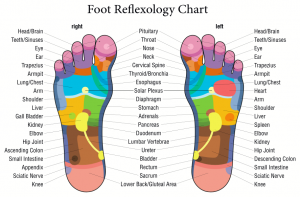Reflexology is an ancient practice that utilizes pressure points on the feet to improve the health of corresponding organs in the body, similar to acupuncture. In this practice, the hands are the main tools used to activate the pressure points. Reflexology was possibly first recorded around 2330 BC as a pictograph on an Egyptian tomb. It is also referenced in Chinese medical text around 1,000 BC and has continued to make its way around the world.1 Now, basic reflexology techniques are made accessible to the average person to learn on their own. Better yet, you can also find a professionally certified reflexologist or specialized message therapist who has proper educational training.
The University of Minnesota states, “Reflexology may be beneficial in restoring balance and harmony in the body and releasing tension. Practitioners believe that it helps facilitate a deep state of relaxation, calm the emotions, and produce a serene mind. Research studies support many of these benefits.”1 Reflexology is thought to work in several different ways. The first theory is that reflexology works with the central nervous system by signaling the body to adjust tension levels, promote overall comfort and increase blood supply. The second theory is that reflexology reduces pain by reducing stress and therefore improving mood. Similarly, the third theory also works on the neuromatrix idea of perceived pain but also suggests that reflexology impacts the bodies “vital energy,” also known as Qi. Lastly, the fourth theory works on the idea of body zones, where the body is divided into 10 vertical zones and each corresponds to the fingers and toes leading to the head. Here, reflexology would also impact the organs via the central nervous systems through body zones. No matter which theory, reflexologists believe that when you apply pressure to specific areas on the feet, you are in turn supplying healing power to the corresponding organ. Ready to get some energy flowing on your own?

Before you start working on your feet, find a relaxing place to sit and make sure both your feet and hands are clean, and nails trimmed. You can even heat your feet first with a warm rice pack. Next, find a good foot map you can follow, many can be found easily online for reference. You can also purchase reflexology socks that have foot maps printed on them. To improve the atmosphere, you may want to play some relaxing music or light a candle. For beginners, a technique called “ring reflexology” can be used to reduce chances of missing the actual reflex.2 To master this technique, simply place your thumb on a reflex and move in a circular direction counterclockwise. Spend about 10-15 seconds rolling or rocking on each point before moving to the next. Work on the desired pressure points during your session and reap the benefits of showing your feet a little love. I guess if the eyes are the window to your soul, feet are the window to your organs – who knew?

